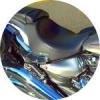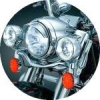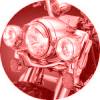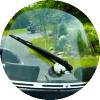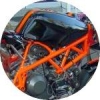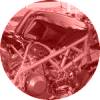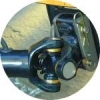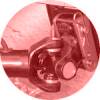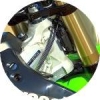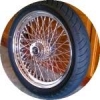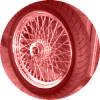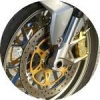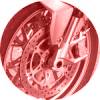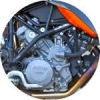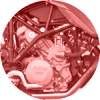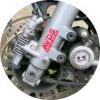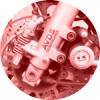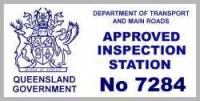Queensland Department of Transport and Main Roads introduced the safety certificate in November 1999 to replace the old roadworthy certificate or RWC, and it became
mandatory to obtain and display a current safety certificate on any registered motorcycle from the moment it's offered for sale.
The only times it's not required to display current safety certificate on a motorcycle for sale is when the motorcycle's either unregistered or is traded to or
between licensed motor dealers.
Queensland Department of Transport and Main Roads safety certificates can only be issued by Approved Inspection Stations (AIS), being service stations, garages or
workshops approved by Queensland Department of Transport and Main Roads to conduct inspections.
For private motorcycle sellers, Queensland Department of Transport and Main Roads safety certificates must be issued in the two months or 2000 kilometres prior to
sale, whichever comes first.
You are required to display a safety certificate in a conspicuous place and for motorcycles it's either on the forks or front guard.
Failure to display a Queensland Department of Transport and Main Roads safety certificate on the motorcycle from the time it's first offered for sale can carry an
on-the-spot fine penalty of $550.
Information on this website relating to motorcycle inspection is drawn from the Queensland Department of Transport and Main Roads Code of Practice for Approved
Inspection Stations (AIS) and Approved Persons; guidelines followed during safety certificate inspections and vehicle modification certification.
Following the code of practice guidelines below and rectifying faults you uncover should assure your motorcycle will pass on first inspection, avoiding any inconvenient
and possible costly re-inspection.
Vehicle inspection is subjective and the guidelines open to varying interpretation from inspector to inspector. Below is a list of reasons for possible rejection
pertaining to the Lights and Electrical Components for the issuing of a Queensland Department of Transport and Main Roads safety certificate (formerly roadworthy
certificate or RWC).
SECTION 2 - LAMPS (LIGHTS) AND ELECTRICAL COMPONENTS
Objective: To ensure that all lamps, reflectors and other electrical lighting components are operational and to ensure the vehicle’s electrical
system is secured and operating correctly.
In this section:-
Lighting component includes lamps, reflectors, lens and lamp reflectors.
2.1 LIGHTING EQUIPMENT
Possible reasons for inspection rejection:
- Lighting components fitted to a vehicle are not operational, are damaged or not located in positions as required by prescribed standards. (See Note 8)
- Any lighting component has a tinted or opaque cover or tinting applied to it. (See Note 1)
- Lighting components, including additional lighting, are not clearly visible under all normal conditions and of a consistent intensity
or are affected by dirty or discoloured lenses or poor electrical contact.
- Lighting components are not securely mounted, are faded, discoloured or are not free from cracks, holes or other damage which would
allow the entry of moisture or dirt to impair the efficiency of the component. (See Note 2)
- The number plate lamp/s direct/s light onto surfaces other than the rear number plate.
- Any rear facing lamp, other than a reversing lamp, shows white light to the rear of the vehicle.
- Any optional/additional lighting component interferes with the effective operation of any compulsory lighting component.
- A lighting component is fitted which is not required or permitted by Vehicle Standards or another law. (See Note 4)
- The vehicle is fitted with a flashing light (apart from indicators and hazard lamps). (See Note 7)
2.2 HEADLIGHT/S
Possible reasons for inspection rejection:
- Headlamps are not correctly focused or aimed. (See Note 3, 11 and 12)
- Reflector surfaces are tarnished or have other damage that reduces the intensity of low or high beam.
- Headlamps are not of a consistent intensity.
- The light from the headlamp is obstructed by the fitment of other components (for example bull bars, nudge bars or fishing rod
holders).
- A dipping device to change the headlamps from the high beam position to the low beam position and operated by the driver from the
normal driving position is not fitted or operational. (See Note 6)
- A device to indicate to the driver that the headlamps are in the high beam position is not fitted or operational. (See Note 5)
- High Intensity Gas-Discharge (HID) assemblies are not self-levelling, do not have a wash/wipe function (light vehicles only) and/or do
not disperse the light correctly.
- The following lamps (where applicable) do not operate correctly or do not emit the colour light (as indicated):
- front park or side lamps (white);
- brake lamps (red);
- tail lamps (red);
- turn signal indicator lamps (amber (or white if prior to 1973);
- rear facing signal indicator lamps (yellow/amber/red (prior to 1973);
- hazard warning lamps (yellow/amber);
- clearance/side marker lamps (if fitted) (front - yellow/white, side - yellow/amber, rear - yellow/amber and red) (See Note 9 and
10);
- number plate lamp/s (white);
- reversing lamps/s (yellow/amber (pre-1989 vehicles only) or white);
- additional lamps (if fitted). (See Note 4)
2.3 OTHER LIGHTS AND REFLECTORS (See Note 4)
Possible reasons for inspection rejection:
- The reverse lamp (if applicable) operates other than when reverse gear is selected.
- Any yellow/amber clearance lamp (if fitted) or front turn signal lamp (vehicle manufactured from January 1973) shows white light.
- The turn signal switch is not readily operable by the driver from the driving position.
- The turn signal operation is not indicated by means of a visible and/or audible telltale.
- Additional headlamps (driving lamps) do not operate in conjunction with the high beam circuit only and are not fitted with an
independent on/off switch. (See Note 13)
2.5 REAR MARKING PLATES
Possible reasons for inspection rejection:
- Do not overtake turning vehicle marker plates are fitted to a vehicle with a length less than 7.5m.
- Retro/reflective rear marker plates are fitted and are damaged, faded, discoloured or insecure.
- Retro/reflective rear marker plates do not comply with the relevant Australian Standard and are not fitted in locations specified by
the prescribed standards. (See Note 14)
2.6 WIRING HARNESS
Possible reasons for inspection rejection:
- Electrical wiring is not securely mounted or is located in such a way that would make the vehicle unsafe.
- Electrical wiring is not correctly insulated or is exposed to excessive heat or chafing.
- Electrical wiring or connectors hinder driver or passenger movement or are hanging loose.
2.7 BATTERY
Possible reasons for inspection rejection:
- A battery is not secured in a cradle or carrier using hold down clamps.
- A battery is cracked, is leaking or has missing caps.
- Batteries fitted in enclosed areas (i.e. boot, cabin and so on) are not fitted in a sealed container which is adequately vented to the
outside of the vehicle.
2.8 WARNING DEVICE (Horn)
Possible reasons for inspection rejection:
- A warning device is not fitted or operational and the tone is not of a single pitch (Dual air or electrical horns are acceptable
provided they are of a single pitch).
- A warning device is not clearly audible or the actuating mechanism is not located within the reach of the driver in the normal driving
position.
Notes about Section 2 (Lamps (Lights) and Electrical Components)::
[1] Headlamps may be fitted with opaque covers provided they can be readily removed without the use of tools. (clear headlamp covers are acceptable provided the
intensity of high or low beam is not affected)
[2] Lens repairs are acceptable but must not reduce the effectiveness of the lamp when the lamp is lit.
[3] Headlight aim is to be tested on a graduated screen placed 9 metres in front of the vehicle or by using an approved type headlight testing machine. An example of
an approved headlight testing screen is shown in Information Sheet No. 4 in Vehicle Standards Instruction G21 - Information Sheets for Approved Examiners.
[4] Further information on lamps/lights is contained in Information Sheets No. 8 and 9 in Vehicle Standards Instruction G21 - Information Sheets for Approved
Examiners.
[5] A motor vehicle built after 1953 must be fitted with a device to indicate to the operator that the headlamps are in the high beam position.
[6] A motor vehicle built after 1934 that can travel at over 60 km/h must be fitted with a dual beam (dipping high/low) headlamp system.
[7] Flashing lights are permitted on special use vehicles i.e. emergency vehicles and vehicles fitted or built for use in hazardous situations on a road.
[8] For vehicles which are fitted with Light Emitting Diode (LED) lamp assemblies and of which some individual LEDs are not operating on a particular unit, it will be
permissible to accept individual LED lamp assemblies if up to and including 20% of the LEDs in an individual assembly are not operating.
That is, if an LED lamp assembly has:
- 9 individual LEDs, it will be acceptable to have 1 LED not working
- 10 individual LEDs, it will be acceptable to have 2 LEDs not working
- 22 individual LEDs, it will be acceptable to have 4 LEDs not working
[9] For pre-ADR vehicles, clearance lamps must be fitted to all vehicles which exceed 2.2 metres in width and be mounted not more than 400mm in from the side
of the vehicle, at least 750mm higher than the centre of any low beam headlamp or not lower than the top of the windscreen.
[10] Clearance lamps must be fitted to ADR complying vehicles which exceed 2.1 metres in width, be mounted not more than 400mm in from the side of the vehicle and not
lower than the top of the windscreen.
[11] ADR complying vehicles - maximum low beam headlamp height is 1200mm.
[12] Pre- ADR vehicles - maximum low beam headlamp height is 1400mm.
[13] Driving lamps may be fitted in odd numbers only if they comply with Vehicle Standards Instruction G15 - Fitment and use of driving lamps including light emitting
diode (LED) light bars on vehicles.
[14] Further information on rear marker plates is contained in Vehicle Standards Bulletin (VSB) 12 - Rear Marking Plates available from www.infrastructure.gov.au






















